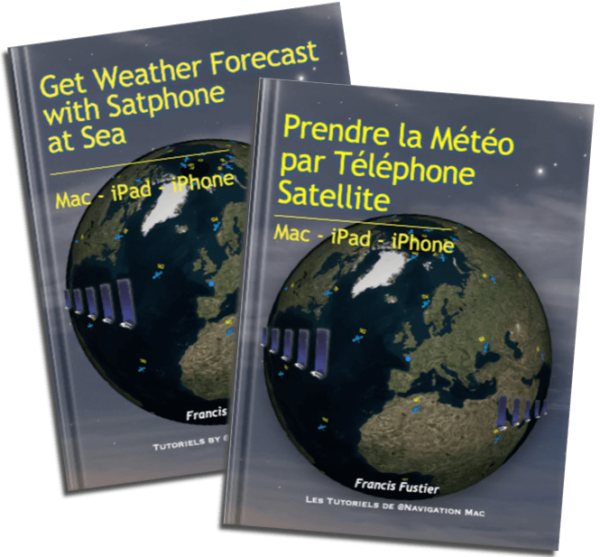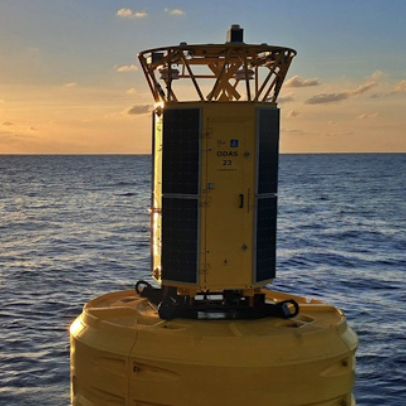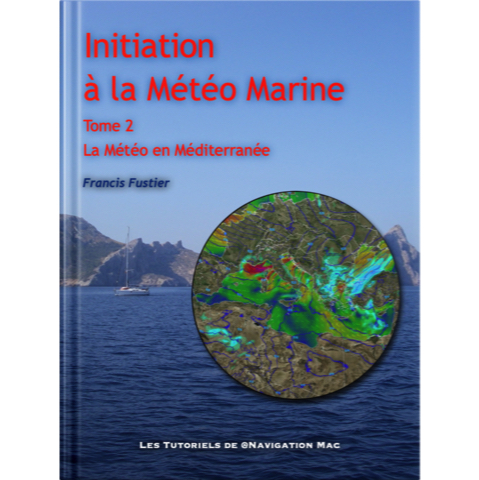Weather and ocean data In-situ are observational data broadcast in real time, or quasi-real, from different sources : semaphores, ships at sea, fixed or drifting buoys, airports, and also specialized satellites. This data is available as open data to the general public and also for reuse by the economic sphere.. The new NavimetriX application allows you to display this data to complete the forecasts of models distributed in GRIB format. Read more …
Category : Meteorology
Get Weather Forecast with Satphone at Sea [MAY V.2.3]
 Update 2.3 (November 2025) of the guide Get Weather Forecast with Satphone at Sea French version.
Update 2.3 (November 2025) of the guide Get Weather Forecast with Satphone at Sea French version.
- Removing Iridium Mail&Web app (*)
- Alternative apps
- Updated Starlink conditions and services as of November 1 2025.
[ADDENDUM] After a long and bitter battle with Apple, the process of updating works has finally been corrected in iTunes Connect and the version 2.3 is finally available for download. However the version number is still not implemented (except on the pages of the book).
Reading : "Climate and weather scientific atlas" The world nature
 The newspaper Le Monde published in November 2024 this great study in his collection « Nature ».
The newspaper Le Monde published in November 2024 this great study in his collection « Nature ».
Prefaced by Jean-Louis Etienne, our national explorer that we no longer present, this extremely didactic scientific work allows us to deepen our knowledge of the climate, meteorology, and disturbances they undergo.
Tutorial : Weather in the Mediterranean Update V.1.2
March, the volume 2 from Introduction to Marine Weather – Weather in the Mediterranean, is updated on the iBook Store (Apple Books)
Version 1.2 – Layout improvements and link fixes.
- 88 pages
- 48 screenshots
- 14 videos
Warning : A severe bug still unfixed affects the new process for uploading book updates. The version number is no longer replaced on the iBook Store and remains "Original". On the other hand, the description of the modifications is present. Once again : thank you Apple !
–––
Météo-France in the storm
 After NOAA, which has just suffered the wrath of the Trump administration (1), here is the Météo-France institute in turn pinned by the national press. After the newspaper La Dépêche on March 24 th, Le Monde adds on April the 20 th (2) by taking stock of the situation and studying the causes of the recent errors that have occurred several times in the weather forecasts of recent months Read more …
After NOAA, which has just suffered the wrath of the Trump administration (1), here is the Météo-France institute in turn pinned by the national press. After the newspaper La Dépêche on March 24 th, Le Monde adds on April the 20 th (2) by taking stock of the situation and studying the causes of the recent errors that have occurred several times in the weather forecasts of recent months Read more …
Météo-France strengthens its observations in the Mediterranean [Update]
 Following the catastrophic weather phenomenon that hit Corsica on 18 August 2022, causing considerable damage, Météo-France has undertaken to deploy additional resources in the western Mediterranean to better predict the occurrence of such phenomenon.
Following the catastrophic weather phenomenon that hit Corsica on 18 August 2022, causing considerable damage, Météo-France has undertaken to deploy additional resources in the western Mediterranean to better predict the occurrence of such phenomenon.
March, the 5 th 2025, Météo-France has launched the fifth in a series of weather buoys anchored off the coast of France northwest of Corsica. This deployment is part of the reinforcement of the sea observation system, initiated in June 2023, and aims to improve local capacity to anticipate extreme weather events before they reach land. Read more …
Tutorial : Weather in the Mediterranean Update V.1.1
 March, the volume 2 from Introduction to Marine Weather – Weather in the Mediterranean, is updated on the iBook Store (Apple Books)
March, the volume 2 from Introduction to Marine Weather – Weather in the Mediterranean, is updated on the iBook Store (Apple Books)
Version 1.1 – Addition of a paragraph on Advanced thunderstorm forecasting data.
- 88 pages
- 48 screenshots
- 14 videos
–––
ECMWF's AIFS Forecasting Model Becomes Operational
 Tuesday 25 February 2025, A new version of the deterministic model of the artificial intelligence forecasting system (AIFS) has been published and operationally implemented. This update marks a turning point in ECMWF's history, since AIFS Single v1 is the first AIFS model to be rendered fully operational (¹). Read more …
Tuesday 25 February 2025, A new version of the deterministic model of the artificial intelligence forecasting system (AIFS) has been published and operationally implemented. This update marks a turning point in ECMWF's history, since AIFS Single v1 is the first AIFS model to be rendered fully operational (¹). Read more …
NOAA in danger : bad weather for meteorology !
 The National Oceanic and Atmospheric Administration (NOAA) employs approximately 12 000 people around the world, more than half of whom are scientists and engineers. NOAA Operates 18 satellites and 15 vessels and has a budget of 6,8 billion dollars. Through various services, its job is to study the atmosphere (National Weather Service), study the oceans, fish resources, charting the seas (National Ocean Service), to follow their evolution and predict their future (Office of Oceanic and Atmospheric Research). NOAA's work is critical for aviation, Navy, fishing, climate research and offshore oil and gas exploration, especially when it comes to modelling weather patterns and climate change. Read more …
The National Oceanic and Atmospheric Administration (NOAA) employs approximately 12 000 people around the world, more than half of whom are scientists and engineers. NOAA Operates 18 satellites and 15 vessels and has a budget of 6,8 billion dollars. Through various services, its job is to study the atmosphere (National Weather Service), study the oceans, fish resources, charting the seas (National Ocean Service), to follow their evolution and predict their future (Office of Oceanic and Atmospheric Research). NOAA's work is critical for aviation, Navy, fishing, climate research and offshore oil and gas exploration, especially when it comes to modelling weather patterns and climate change. Read more …
New tutorial : Weather in the Mediterranean
March, the volume 2 from Introduction to Marine Weather has been published on the iBook Store (Apple Books)
The Mediterranean Sea has a unique configuration in the world. An enclosed maritime area of nearly two thousand nautical miles from west to east, it is only open to the Atlantic by a strait of eight nautical miles. Read more …


